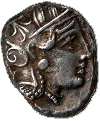


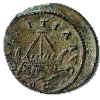
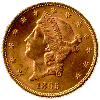
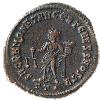
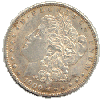
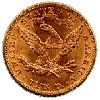
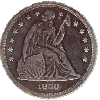
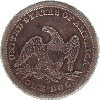
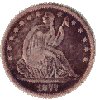
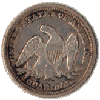

|
Obverse (Heads side) of an Athenian tetradrachm of about 350 B. C. The lady depicted is Athena, patron goddess of the City - State of Athens. This coin was first struck about 480 B. C. and was issued for the next one hundred fifty years or so. The style of the portrait changed slightly during this time period. This is a later issue. The earlier tetradrachms had a large, oval eye on the side of Athena's face face |

|
This is the reverse (Tails side) of the Athenian tetradrachm whose obverse is illustrated above. The Athenian owl became a recognized symbol of economic power throughout the Eastern Mediterranean during the Golden Age of Athens (About 480 - 400 B. C.) Merchants could rely on this coin being of good silver and honest weight even if they couldn't read the three Greek Letter abbreviation of the city's name. |

|
This is an early United States Bust Half Dollar struck in the year 1837. Bust style halves were struck from 1792 to 1838. Even though the U. S. coins struck during the late Eighteenth Century, especially between 1792 and 1795 are extremely rare, they aren't very old as coins go. They are just very popular amongst collectors. |

|
This ship on the reverse of a Roman Imperial coin of Allectus (A. D. 293 - 295) was probably one of the Saxon Shore Fleet, whose job it was to defend Roman Britain against pirates infesting the English Channel. In a classic tale of pirate hunter turned pirate himself and actually stealing an entire kingdom, please see the articles on Carausius and Allectus at my other site. |

|
This is the obverse of a U. S. twenty dollar gold double eagle. When gold was discovered in California in 1849, it suddenly became quite plentiful. Prior to that time, the largest denomination U. S. coin was the gold ten dollar eagle. The introduction of the double eagle in 1849 provided a handy market for the gold mined during the California gold rush. |

|
This is an image of the Roman goddess Juno Moneta, a personnification of coined money. Her attributes (symbolic items usually shown with her in images) include a balance scale for weighing money and a cornucopia, or horn of plenty. |

|
The famous U. S. "Morgan" silver dollar shown here was struck from 1878 to 1904, and then again in 1921 prior to the introduction of the peace type dollar. This is "John Wayne money", the coin gunslingers always threw down on the saloon bar in the old Western movies when they hollered,"Gimme Whiskey!" |

|
This is thr reverse of the U. S. ten dollar eagle gold piece. This type was struck from 1834 to 1907. The last eagle of any type was struck in 1933, but most of these final year pieces were melted by the U. S. Treasury Department after President Franklin Delano Roosevelt's Gold Surrender Order. This ill - conceived act of official piracy instantly cut the value of a dollar in half, thus ripping off millions of hardworking Americans with savings accounts. It was intended to reverse the effects of the Great Depression, but it was the overwhelming ramp - up of American industry and not FDR which was responsible for ending the depression in the U. S. |

|
This is an example of the U. S. seated dollar struck from 1836 until 1873. The seated design was used on all U. S. silver coins from the dime through half dollar from 1838 until 1891 and on the half dime until 1877. The seated dollar is not as popular and well - known today as the Morgan type depicted above. The example shown here, struck in 1859 in the city of New Orleans, is one of the few common dates of the series. |

|
This is the reverse of the seated dollar illustrated above. Note the "O" mintmark under the eagle's claws (You might have to go back to the Economic Systems page to see it more clearly in the large photo.) This letter stood for the U. S. Mint in New Orleans, Louisiana. |

|
This is the obverse of an 1877 U. S. seated half dollar. The design is very similar to the design on the dime, twenty - cent piece, and quarter of the same year. |

|
This is the reverse of a seated quarter struck before 1861. Like all seated coinage struck before that year, it does not have a banner with the legend "In God We Trust" above the eagle. |
Return to Roman Economy Contents Page
The Ancients' First Use of Money
Some Different Economic Systems in History
About the Coins Illustrating this Series of Articles
What are the Functions of Money?